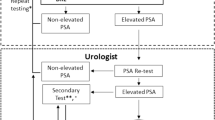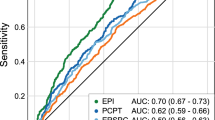Abstract
Recent studies have reported enhanced prostate cancer detection in Caucasians with serum human glandular kallikrein 2 (hK2) in combination with total- (tPSA) and free-prostate-specific antigen (fPSA). The purpose of this study is to validate these findings in an African-American patient cohort. A total of 137 African-American men were found by routine screening to have tPSA levels above 2.5 ng/ml or an abnormal digital rectal examination. Sera were drawn prior to biopsy of the prostate and Hybritech® PSA, FPSA and hK2 (for research use only, not for use in diagnostic procedures) concentrations were determined on Beckman Coulter's Access® immunoanalyzer. These independent variables and the ratios of percent fPSA (%fPSA), hK2/tPSA, hK2/fPSA, and hK2*tPSA/fPSA were compared between cancer and non-cancer groups. In all, 49 of 137 men had prostate cancer. hK2 and its calculated ratios outperformed tPSA on receiver operator characteristic (ROC) analysis, but %fPSA had statistically the highest area under the curve (AUC) at 0.801. When restricting the analysis to only the tPSA range of 4.0–10 ng/ml, hK2/fPSA yielded the highest AUC (0.721). The ratio of hK2/fPSA was also found to increase the positive predictive value (PPV) of the %fPSA ranges less than 10 and 10–25%. %fPSA offered the best performance and highest specificity in prostate cancer detection in African-American males over the entire range of tPSA. hK2/fPSA may offer modest improvement in the tPSA range of 4.0–10 ng/ml. Furthermore, hK2/fPSA can enhance the PPV of low %fPSA values. Therefore, the use of multiple biomarkers may ultimately increase the specificity of prostate cancer screening in African-American men.
This is a preview of subscription content, access via your institution
Access options
Subscribe to this journal
Receive 4 print issues and online access
$259.00 per year
only $64.75 per issue
Buy this article
- Purchase on Springer Link
- Instant access to full article PDF
Prices may be subject to local taxes which are calculated during checkout


Similar content being viewed by others
References
Paquette EL et al. Improvements in pathologic staging for African-American men undergoing radical retropubic prostatectomy during the prostate specific antigen era. Cancer 2001; 92: 2673–2679.
Bartsch G et al. Prostate cancer mortality after introduction of prostate-specific antigen mass screening in the Federal State of Tyrol, Austria. Urology 2001; 58: 417–424.
Kubota Y, Ito K, Imai K, Yamanak H . Effectiveness of mass screening for the prognosis of prostate cancer patients in japanese communities. Prostate 2002; 50: 262–269.
Catalona WJ, Smith DS, Ornstein DK . Prostate cancer detection in men with serum PSA concentrations of 2.6 to 4.0 ng/ml and benign prostate examination. Enhancement of specificity with free PSA measurements. JAMA 1997; 277: 1452–1455.
Smith DS et al. Use of lower prostate specific antigen cutoffs for prostate cancer screening in black and white men. J Urol 1998; 160: 1734–1738.
Okihara K et al. Comparative analysis of complexed prostate specific antigen, free prostate specific antigen and their ratio in detecting prostate cancer. J Urol 2002; 167: 2017–2024.
Tanguay S et al. Comparative evaluation of total PSA, free/total PSA, and complexed PSA in prostate cancer detection. Urology 2002; 59: 261–265.
Brawer MK, Cheli CD, Neaman IE . Complexed prostate specific antigen provides significant enhancement of specificity compared with total prostate specific antigen for detecting prostate cancer. J Urol 2000; 163: 1476–1480.
Rittenhouse HG, Finlay JA, Mikolajczyk SD, Partin AW . Human kallikrein 2 (hK2) and prostate-specific antigen (PSA): two closely related, but distinct, kallikreins in the prostate. Crit Rev Clin Lab Sci 1998; 35: 275–368.
Charlesworth MC et al. Detection of a prostate-specific protein, human glandular kallikrein (hK2) in sera of patients with elevated prostate-specific antigen levels. Urology 1997; 49: 487–493.
Kwiatkowski MK et al. In prostatism patients the ratio of human glandular kallikrein to free PSA improves the discrimination between prostate cancer and benign hyperplasia within the diagnostic ‘gray zone’ of total PSA 4 to 10 ng/Ml. Urology 1998; 52: 360–365.
Partin AW et al. Use of Human glandular kallikrein 2 for the detection of prostate cancer: preliminary analysis. Urology 1999; 54: 839–845.
Becker C et al. Discrimination of men with prostate cancer from those with benign disease by measurement of human glandular kallikrein 2 (hK2) in serum. J Urology 2000; 163: 311–316.
Becker C et al. Clinical value of human glandular kallikrein 2 and free and total prostate-specific antigen in serum from a population of men with prostate-specific antigen levels 3.0 ng/ml or greater. Urology 2000; 55: 694–699.
Nam RK et al. Serum human glandular kallikrein-2 protease levels predict the presence of prostate cancer among men with elevated prostate-specific antigen. J Clin Oncol 2000; 18: 1036–1042.
Catalona WJ, Antenor JV, Roehl KA . Screening for prostate cancer in high risk populations. J Urol 2002; 168: 1980–1984.
Brawley OW, Knopf K, Merrill R . The epidemiology of prostate cancer part I: descriptive epidemiology. Semin Urol Oncol 1998; 16: 187–192.
Miller BA et al. Cancer statistics review: 1973–1989. National Cancer Institute:Bethesda, MD 1992.
Gargiullo P et al. Recent trends in mortality rates for four major cancers, by sex and race—United States, 1990–1998. MMWR 2002; 51: 49–53.
Magklara A et al. The combination of human glandular kallikrein and free prostate-specific antigen (PSA) enhances discrimination between prostate cancer and benign prostatic hyperplasia in patients with moderately increased total PSA. Clin Chem 1999; 45: 1960–1966.
Riegman PH et al. Characterization of the human kallikrein locus. Genomics 1992; 14: 6–11.
Yousef GM, Eleftherios PD . The new human tissue kallikrein gene family: structure, function, and association to disease. Endocrine Rev 2001; 22: 184–204.
Darson MF et al. Human glandular kallikrein 2 expression in prostate adenocarcinoma and lymph node metastases. Urology 1999; 53: 939–944.
Herraha AM et al. Comparison of human prostate specific glandular kallikrein 2 and prostate specific antigen gene expression in prostate with gene amplification and overexpression of prostate specific glandular kallikrein 2 in tumor tissue. Cancer 2001; 92: 2975–2984.
Stamey TA et al. Molecular genetic profiling of gleason grade 4/5 prostate cancers compared to benign prostatic hyperplasia. J Urol 2001; 166: 2171–2177.
Magklara A et al. Decreased concentrations of prostate-specific antigen and human glandular kallikrein 2 in malignant versus nonmalignant prostatic tissue. Urology 2000; 56: 527–532.
Scorilas A et al. Serum human glandular kallikrein (hK2) and insulin-like growth factor 1 (IGF-1) improve the discrimination between prostate cancer and benign prostatic hyperplasia in combination with total and %free PSA. Prostate 2003; 54: 220–229.
Recker F et al. Human glandular kallikrein as a tool to improve discrimination of poorly differentiated and non-organ confined prostate cancer compared with prostate-specific antigen. Urology 2000; 55: 481–485.
Haese A et al. The role of human glandular kallikrein 2 for prediction of pathologically organ confined prostate cancer. Prostate 2003; 54: 181–186.
Author information
Authors and Affiliations
Corresponding author
Rights and permissions
About this article
Cite this article
Martin, B., Finlay, J., Sterling, K. et al. Early detection of prostate cancer in African-American men through use of multiple biomarkers: human kallikrein 2 (hK2), prostate-specific antigen (PSA), and free PSA (fPSA). Prostate Cancer Prostatic Dis 7, 132–137 (2004). https://doi.org/10.1038/sj.pcan.4500706
Received:
Revised:
Accepted:
Published:
Issue Date:
DOI: https://doi.org/10.1038/sj.pcan.4500706
Keywords
This article is cited by
-
Performance of Pharmacovigilance Signal-Detection Algorithms for the FDA Adverse Event Reporting System
Clinical Pharmacology & Therapeutics (2013)
-
The Eastland Prostate Cancer Survey: Instrument Development and Psychometric Testing
Journal of Cancer Education (2013)
-
Empirical Performance of a New User Cohort Method: Lessons for Developing a Risk Identification and Analysis System
Drug Safety (2013)
-
Real-time quantitative RT-PCR assessment of PIM-1 and hK2 mRNA expression in benign prostate hyperplasia and prostate cancer
Medical Oncology (2009)
-
A panel of kallikrein markers can reduce unnecessary biopsy for prostate cancer: data from the European Randomized Study of Prostate Cancer Screening in Göteborg, Sweden
BMC Medicine (2008)



